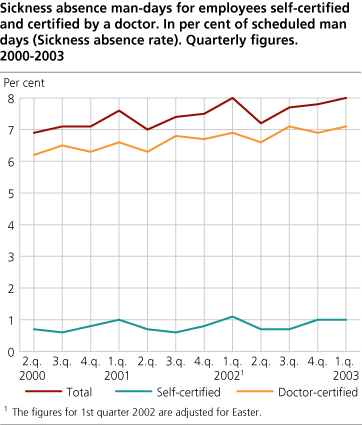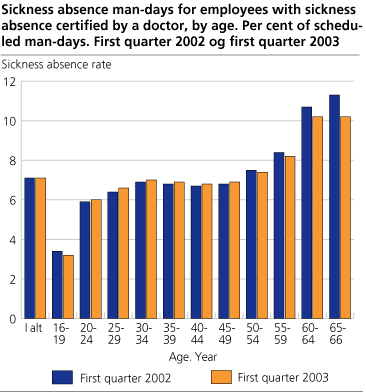Content
Published:
This is an archived release.
No growth in sickness absence
The total sickness absence rate for the first quarter 2003 was 8.1. This is the same level as first quarter 2002 if we make up for the effect of Easter. Women had a decline in sickness absence rate by 0.1 percentage points while men had an increase of 0.1.
The doctor-certified sickness absence was 7.1 percentage points and the self-certified was 1.0. Rounding gives us a total sickness absence rate of 8.0.
Without adjusting for Easter first quarter 2002 the sickness absence rate this quarter was 8.2. This article and the tables present figures that are not adjusted for Easter. Adjusted for the effect of Easter the sickness absence rate for most groups first quarter 2002 would be 0.1-0.2 percentage points lower.
No growth in sickness absence rate in most industries
The sickness absence rate decreased or was stable in all industries except primary industries and construction. The decrease was strongest in public administration and defence, education, health and social work and other social and personal services.
Lower doctor certified sickness absence among the oldest
The following comments are based on the figures for sickness absence certified by a doctor, which represents approximately 86 per cent of the total absence. The survey on self-certified absence does not include the variables age or county of residence.
The sickness absence rate decreased in all age groups from 50 years and older from the first quarter 2002 to the first quarter 2003. The age group 65-66 decreased by 1.1 percentage points. In the age groups 20-24, 25-29, 30-34 and 40-44 years the absence increased by 0.1 percentage points. Women aged 30-34 and 50-54 had a decrease in doctor-certified absence of 0.2 and 0.5 percentage points, respectively. Men in the same age groups had an increase of 0.2 percentage points and no growth, respectively.
Decrease in Oslo and Sør-Trøndelag
Oslo had a decrease from 6.7 to 6.5 per cent from the first quarter 2002 to the second quarter 2003. Sør-Trøndelag county had a decrease from 7.3 to 7.1 per cent in the same period. Østfold, Vestfold, Telemark and Vest-Agder had an increase in the doctor-certified sickness absence of 0.2 percentage points.
Women had a decrease in absence in Oslo, Aust-Agder and Troms of 0.3, 0.4 and 0.3 percentage points, respectively. Men in Sør-Trøndelag also had a considerable decrease in sickness absence, 0.4 percentage points. Men in Telemark and Aust-Agder had a large increase, 0.5 and 0.4 percentage points, respectively.
Extended right to self-certified absence
The share of establishments with the right to extended self-certified sickness absence was higher in first quarter 2003 than first quarter 2002. However, the figures for self-certified absence show no growth in self-certified absence in this period.
Adjustment for Easter
Easter was in the first quarter in 2002, and in the second quarter in 2001. This influences the comparison of first quarter figures from these two years. Easter has stronger influence on scheduled man-days than on man-days lost due to sickness. If we did not take the Easter week into account the sickness absence rate would have dropped approximately 0.1-0.2 percentage points for most of the groups. The yearly change from 1st quarter 2002 to 1st quarter 2003 would have been respectively higher.
Sickness absence statistics in Statbank Norway
Statbank Norway is a service containing detailed statistics on the Internet. The English version will be online soon and will contain sickness absence statistics by sex, age, industry and county of residence.
Tables:
- Table 1 Sickness absence man-days for employees self-certified and certified by a doctor. In per cent of scheduled man-days (Sickness absence rate). Quarterly figures. 2000-2003
- Table 2 Sickness absence man-days for employees self-certified and certified by a doctor, by sex. In per cent of scheduled man-days (Sickness absence rate). Quarterly figures. 2000-2003
- Table 3 Sickness absence man-days for employees self-certified and certified by a doctor, by industry and type of sickness absence. In per cent of scheduled man days (Sickness absence rate). Quarterly figures. 2000-2003
Contact
-
Arbeidsmarked og lønn
E-mail: arbeidsmarked@ssb.no
-
Unn H. Høydahl
E-mail: unnh.hoydahl@ssb.no
tel.: (+47) 40 90 23 77


